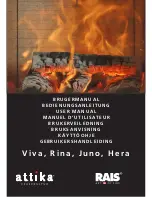
Manual_S5_Airplus_2015_04_20
Page 55 / 68
©
Wodtke GmbH - Tübingen. All Rights and Changes Reserved.Printed 04/2015
Part No. 950 976
Class 1 fault code
Cause of fault
Resolution of fault
LM Er1 =
air volume sensor break
Case A:
air volume sensor break (= component error)
Case B:
external error due to exhaust gas back-flow. Sen-
sor element temperature > 120 °C (also see error descrip-
tion for TL). If the sensor is heated to values > 120 °C due
to exhaust back-flow, this is evaluated as a component er-
ror (break) and the display switches to LM Er1. If the
unit/the sensor has cooled and the sensor is not perma-
nently damaged, the unit can be switched on again.
Case A:
Replace air volume sen-
sor + reset via I/O button.
Case B:
Air volume sensor does
not need to be replaced. Find / re-
solve external error (for reasons,
see errors TL, Hi / TL Grd) then re-
set via I/O button.
LM Er2 =
Air volume sensor short-
circuit
Short circuit = component error
Test / replace air volume
reset via I/O button.
TR Er1 =
Flue gas sensor break
Break = component error
Test / replace TR + reset via I/O
button.
TP Er1 =
Pellet chute sensor break
Break = component error
Test / replace TP manu-
ally
reset
via
I/O button.
TP Er2 =
Pellet chute sensor short-
circuit
Short circuit = component error
Test / replace TP manu-
ally
reset
via
I/O button.
HB Er1 =
control board break or
break in connection cable
from control board to main
board or communication
with Touch Control TC1
(option) disrupted
Break = component error
First test connection cable for con-
tinuity/polarity, etc. and only there-
after
test/replace
control
board/TC1 and manual reset via
I/O button. If the display is broken,
the error is displayed even if the
new control board is already con-
nected. Then briefly press the I/O
button so that the unit recognises
the new control board.
RE Er1 =
Bridge on "Reserve input"
is open
Bridge wire on "Reserve input" open or error on external
component/unit.
Notice: The "Reserve input" serves for feedback from ex-
ternal accessories. It is verified 15 seconds after each start
whether this input is bridged; that is, closed. Only then does
the unit go into the heating programme. The "Reserve in-
put" is then continually inspected. If the bridge on the "Re-
serve input" is opened, a fault shut-down / safety function
occurs (Class 1 error).
Application examples (also see assembly instruc-
tions):
1) Flue gas damper for flue gas: if a mechanical motorised
flue gas damper is used, the normally open contact of this
damper can be connected to the Reserve input. The wodtke
Pellet Primärofen then only operates if the flue gas damper
is opened. If an error occurs on the flue gas damper, the
unit is deactivated via the safety function. The flue gas
damper must open completely by motor within 15 sec, as
otherwise there is an error message because the feedback
to the unit occurs too late.
2) Intake damper for combustion air: for the combustion air:
function, application and wiring like in a flue gas damper.
3) Interlock with ventilation system / extraction hood: if the
ventilation system or extraction hood has a
potential-free
output
as the operating signal, this output can be con-
nected to the Reserve input as normally closed. The wodtke
Pellet Primärofen only operates if the extraction hood/ven-
tilation is not operating. All described examples can be con-
nected electrically in series so that the wodtke Pellet
Primärofen only operates if all external devices are func-
tioning, or deactivates as soon as one single device has a
malfunction.
Check wire bridge on "Reserve in-
put" and insert correctly.
If an external component is con-
nected, check external component
for correct wiring/function (espe-
cially normally open contact) and
replace if necessary.
Afterwards, manual reset via I/O
button.
Attention: A reset of the "RE
Er1" error message and a restart
as a result is only possible if the
"Reserve input" is bridged
(closed) again.
Note: In the case of external de-
vices connected in series,
all
ex-
ternal devices and the
entire
ex-
ternal wiring must be inspected.
Fault code
Class 1
Cause of fault
Resolution of fault














































